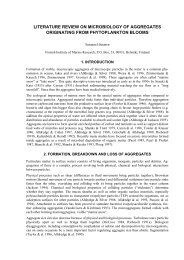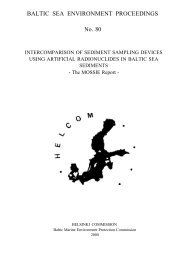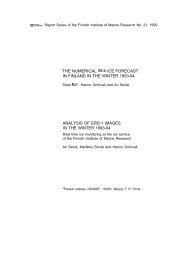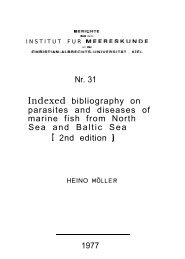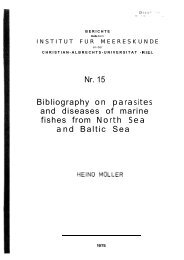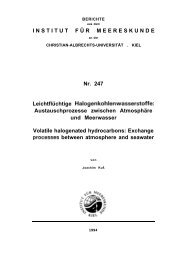marine research in finland - Baltic Marine Environment Bibliography
marine research in finland - Baltic Marine Environment Bibliography
marine research in finland - Baltic Marine Environment Bibliography
Create successful ePaper yourself
Turn your PDF publications into a flip-book with our unique Google optimized e-Paper software.
1.3. Chemical oceanography<br />
The ma<strong>in</strong> emphasis of chemical studies <strong>in</strong> the Institute is to determ<strong>in</strong>e the mass balance of nutrients,<br />
heavy metals and organic compounds <strong>in</strong> the <strong>Baltic</strong> Sea. Field studies were extended to<br />
cover the w<strong>in</strong>ter season <strong>in</strong> the early 1980’s. Before that time, <strong>in</strong>formation was only available for<br />
the ice-free seasons. Determ<strong>in</strong>ations of mass balances require <strong>in</strong>formation on sources and s<strong>in</strong>ks,<br />
and the transport of compounds <strong>in</strong> the water body, as well as their related conceptual models.<br />
Input <strong>in</strong>formation on nutrients is available from load<strong>in</strong>g estimates provided by other authorities,<br />
while the ma<strong>in</strong> s<strong>in</strong>k <strong>in</strong> the area is sedimentation. For this reason, dur<strong>in</strong>g recent years, the study<br />
of recent sediments and their role <strong>in</strong> the mass balance has become the ma<strong>in</strong> focus of chemical<br />
oceanography studies. The Institute participates actively <strong>in</strong> the Sediment Basel<strong>in</strong>e Study of the<br />
<strong>Baltic</strong> Sea, which focuses on a quantitative determ<strong>in</strong>ation of the sedimentation of harmful substances<br />
on the sea bottom. Parameters to be determ<strong>in</strong>ed are the sedimentation rate, and heavy<br />
metal and organochloride concentrations <strong>in</strong> the sediments.<br />
Other focal po<strong>in</strong>ts <strong>in</strong> chemical oceanography studies are the balances and processes of organoclorides<br />
<strong>in</strong> the water phase, denitrification processes, and the development of numerical models<br />
for mass balance studies.<br />
1.4. Biological oceanography<br />
Mar<strong>in</strong>e biological studies rema<strong>in</strong>ed under the aegis of the F<strong>in</strong>nish Society of Sciences and Letters<br />
until they were <strong>in</strong>itiated <strong>in</strong> the Institute <strong>in</strong> the late 1950’s. Today, the Institute has available<br />
long time series on the variability of benthic populations and zooplankton, as well as be<strong>in</strong>g <strong>in</strong>volved<br />
<strong>in</strong> several ongo<strong>in</strong>g projects on microbiology, primary and secondary production as well<br />
as macrozoobenthos.<br />
The dynamics of plankton blooms are under study both <strong>in</strong> coastal stations, jo<strong>in</strong>tly with the Universities,<br />
and on the open sea. The <strong>in</strong>tensity and seasonal variability of the plankton blooms is<br />
studied not only on <strong>research</strong> cruises but also by analys<strong>in</strong>g remote sens<strong>in</strong>g data as well as us<strong>in</strong>g<br />
cont<strong>in</strong>uously-record<strong>in</strong>g fluorometers on passenger ferries. This comb<strong>in</strong>ation of observ<strong>in</strong>g methods<br />
provides good opportunities to verify the relation between eutrophication and the <strong>in</strong>tensity of<br />
blooms <strong>in</strong> a statistically significant manner.<br />
Dur<strong>in</strong>g recent years, studies of toxic cyanobacterial blooms have been <strong>in</strong>cluded <strong>in</strong> the <strong>research</strong><br />
agenda. These studies focus on the hydrodynamic control of the blooms and the trophic web dynamics<br />
of the blooms. Field expeditions which <strong>in</strong>clude the participation of physical, chemical<br />
and biological oceanographers provide simultaneous data on frontal processes, the entra<strong>in</strong>ment<br />
of nutrients and the evolution of blooms. The study of trophic <strong>in</strong>teractions <strong>in</strong>clude phytoplankton<br />
and bacterial production, nutrient uptake and zooplankton graz<strong>in</strong>g pressure.<br />
Dur<strong>in</strong>g most of the growth season <strong>in</strong> the northern <strong>Baltic</strong> Proper, suspended matter exists as aggregates<br />
of organic detritus, micro-organisms and <strong>in</strong>organic particles. In addition to microscopic-size<br />
particles, a substantial fraction ranges <strong>in</strong> size from 500 pm to several centimeters.<br />
The dynamics of these aggregates forms one of the themes <strong>in</strong> the studies of the <strong>Baltic</strong> ecosystem.<br />
Their importance <strong>in</strong> the cycl<strong>in</strong>g of <strong>in</strong>organic nutrients and carbon, their role <strong>in</strong> denitrification<br />
processes and their relation to cyanobacterial blooms is one of the priority areas of the Institute.<br />
Studies of zooplankton focus on analysis of the biotic and abiotic factors which regulate the<br />
zooplankton production and population dynamics <strong>in</strong> the northern <strong>Baltic</strong> Sea. The traditional approach<br />
is comb<strong>in</strong>ed with modem field, experimental and statistical methods.<br />
Zooplankton data collected s<strong>in</strong>ce 1965 at fixed coastal stations provide, jo<strong>in</strong>tly with simultaneous<br />
hydrographical data, good opportunities for the analysis of abiotic <strong>in</strong>fluences on the dynamics.<br />
These data are used <strong>in</strong> comb<strong>in</strong>ation with data from <strong>in</strong>tense study periods on the abundance<br />
and development of the life cycle of the species studied.




